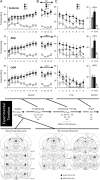Inactivation of the central but not the basolateral nucleus of the amygdala disrupts learning in response to overexpectation of reward
- PMID: 20181588
- PMCID: PMC2836829
- DOI: 10.1523/JNEUROSCI.0054-10.2010
Inactivation of the central but not the basolateral nucleus of the amygdala disrupts learning in response to overexpectation of reward
Abstract
The amygdala is critical for associating predictive cues with primary rewarding and aversive outcomes. This is particularly evident in tasks in which information about expected outcomes is required for normal responding. Here we used a pavlovian overexpectation task to test whether outcome signaling by amygdala might also be necessary for changing those representations in the face of unexpected outcomes. Rats were trained to associate several different cues with a food reward. After learning, two of the cues were presented together, in compound, followed by the same reward. Before each compound training session, rats received infusions of 2,3-dioxo-6-nitro-1,2,3,4-tetrahydrobenzo[f]quinoxaline-7-sulfonamide or saline into either the basolateral (ABL) or central nucleus (CeN) of amygdala. We found that infusions into CeN abolished the normal decline in responding to the compounded cue in a later probe test, whereas infusions into ABL had no effect. These results are inconsistent with the proposal that signaling of information about expected outcomes by ABL contributes to learning, at least in this setting, and instead implicate the CeN in this process, perhaps attributable to the hypothesized involvement of this area in attention and variations in stimulus processing.
Figures

Similar articles
-
Neural correlates of variations in event processing during learning in basolateral amygdala.J Neurosci. 2010 Feb 17;30(7):2464-71. doi: 10.1523/JNEUROSCI.5781-09.2010. J Neurosci. 2010. PMID: 20164330 Free PMC article.
-
Alcohol-Seeking Triggered by Discrete Pavlovian Cues is Invigorated by Alcohol Contexts and Mediated by Glutamate Signaling in the Basolateral Amygdala.Neuropsychopharmacology. 2015 Nov;40(12):2801-12. doi: 10.1038/npp.2015.130. Epub 2015 May 8. Neuropsychopharmacology. 2015. PMID: 25953360 Free PMC article.
-
Neural correlates of variations in event processing during learning in central nucleus of amygdala.Neuron. 2010 Dec 9;68(5):991-1001. doi: 10.1016/j.neuron.2010.11.019. Neuron. 2010. PMID: 21145010 Free PMC article.
-
Associative processes in addiction and reward. The role of amygdala-ventral striatal subsystems.Ann N Y Acad Sci. 1999 Jun 29;877:412-38. doi: 10.1111/j.1749-6632.1999.tb09280.x. Ann N Y Acad Sci. 1999. PMID: 10415662 Review.
-
Role for dopamine in the behavioral functions of the prefrontal corticostriatal system: implications for mental disorders and psychotropic drug action.Prog Brain Res. 2000;126:433-53. doi: 10.1016/S0079-6123(00)26028-7. Prog Brain Res. 2000. PMID: 11105661 Review.
Cited by
-
Mini-review: Prediction errors, attention and associative learning.Neurobiol Learn Mem. 2016 May;131:207-15. doi: 10.1016/j.nlm.2016.02.014. Epub 2016 Mar 3. Neurobiol Learn Mem. 2016. PMID: 26948122 Free PMC article. Review.
-
Engaging endogenous opioid circuits in pain affective processes.J Neurosci Res. 2022 Jan;100(1):66-98. doi: 10.1002/jnr.24762. Epub 2020 Dec 13. J Neurosci Res. 2022. PMID: 33314372 Free PMC article. Review.
-
Neural estimates of imagined outcomes in the orbitofrontal cortex drive behavior and learning.Neuron. 2013 Oct 16;80(2):507-18. doi: 10.1016/j.neuron.2013.08.008. Neuron. 2013. PMID: 24139047 Free PMC article.
-
Neural correlates of two different types of extinction learning in the amygdala central nucleus.Nat Commun. 2016 Aug 17;7:12330. doi: 10.1038/ncomms12330. Nat Commun. 2016. PMID: 27531638 Free PMC article.
-
Context-Dependent and Context-Independent Effects of D1 Receptor Antagonism in the Basolateral and Central Amygdala during Cocaine Self-Administration.eNeuro. 2019 Aug 13;6(4):ENEURO.0203-19.2019. doi: 10.1523/ENEURO.0203-19.2019. Print 2019 Jul/Aug. eNeuro. 2019. PMID: 31358512 Free PMC article.
References
Publication types
MeSH terms
Substances
Grants and funding
LinkOut - more resources
Full Text Sources
Medical
Miscellaneous
